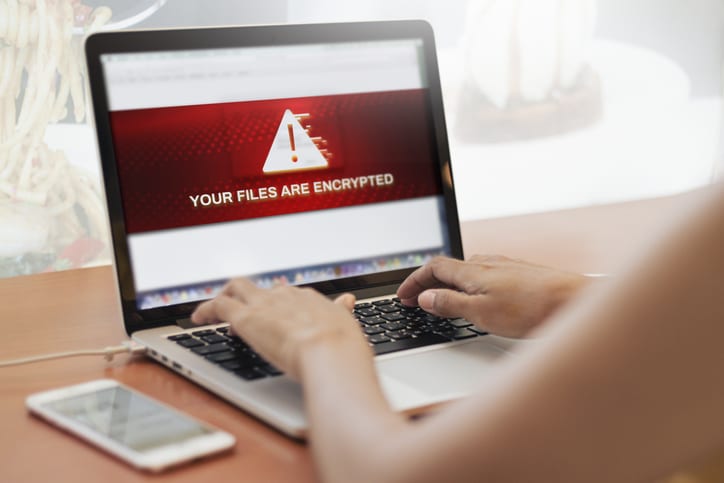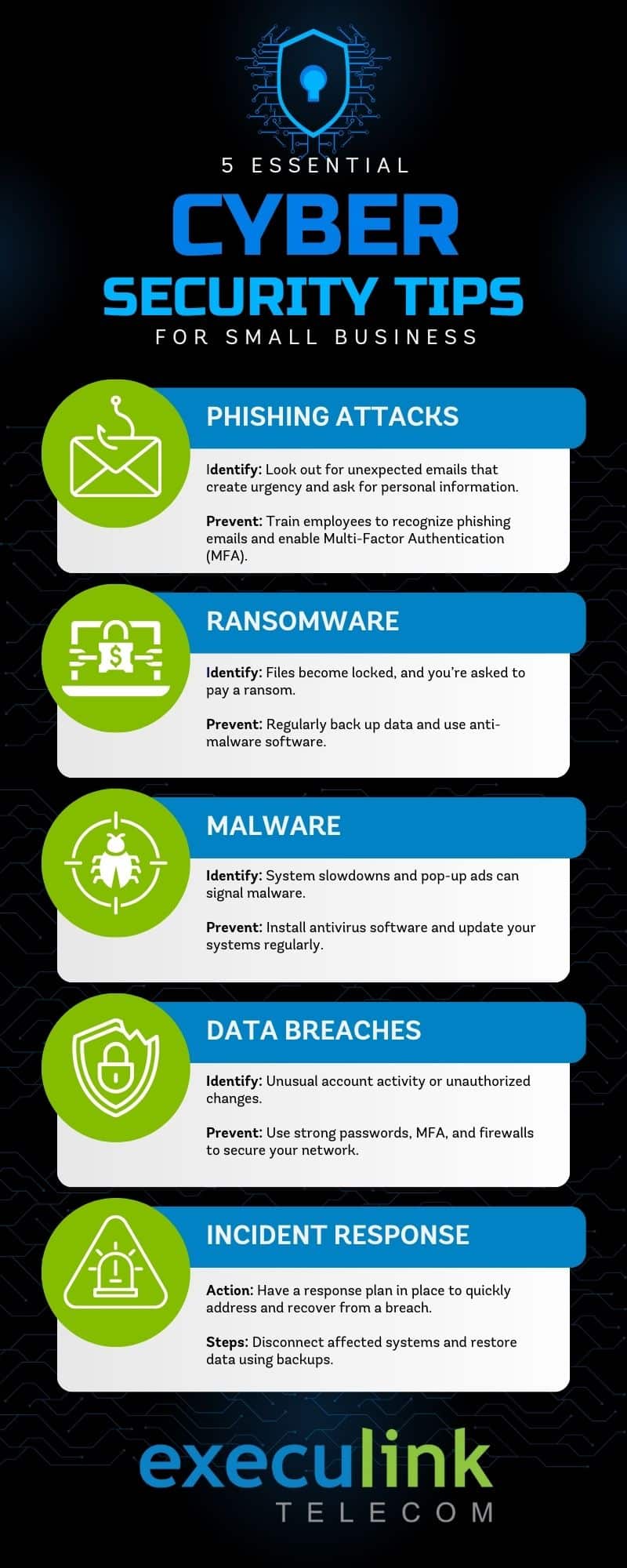Protect Your Small Business: How to Mitigate Common Cyber Threats
October 24, 2024 Category: Business Services, Technical Support
Protect Your Small Business: How to Mitigate Common Cyber Threats
Small businesses face the same cyber threats as larger organizations but often lack the resources to defend themselves. Cybercriminals frequently target small businesses because they assume defenses are weaker. Fortunately, by understanding the most common threats and taking simple steps to mitigate them, you can protect your business from cyberattacks.
Here are the most common cyber threats and the steps you can take to mitigate them.
- Phishing Attacks
What is it?
Phishing occurs when attackers send fraudulent messages (usually via email) to trick individuals into sharing sensitive information such as login credentials or financial data. These messages often appear to come from a trusted source, such as a bank or a well-known business partner.
How to Identify Phishing Attempts:
- Unexpected emails asking for passwords or personal information.
- Messages that create urgency or fear (e.g., “Your account will be locked if you don’t act now!”).
- Suspicious attachments or links to unfamiliar websites.
How to Mitigate Phishing Risks:
- Employee training: Teach employees to recognize phishing emails and avoid clicking on suspicious links or attachments.
- Email filtering: Use filtering software to detect and block phishing attempts before they reach your inbox.
- Enable Multi-factor Authentication (MFA): This adds an extra layer of protection to accounts even if login credentials are compromised.
- Ransomware
What is it?
Ransomware is a type of malware that locks or encrypts your files until a ransom is paid. These attacks can be devastating to small businesses, often forcing operations to halt until the issue is resolved.
How to Identify a Ransomware Attack:
- Files become inaccessible or encrypted.
- A ransom demand is presented on the screen.
- Unusual system performance or slowdowns.
How to Mitigate Ransomware Risks:
- Regular backups: Regularly back up your data to a secure location (cloud or external hard drives) and test these backups to ensure they work.
- Anti-ransomware software: Use anti-malware software designed to detect and prevent ransomware.
- Access control: Restrict access to sensitive data and ensure only necessary personnel can make changes.
- Malware
What is it?
Malware is any type of malicious software designed to harm your computer systems or steal data. This can include viruses, spyware, and trojans.
How to Identify Malware Infections:
- Systems are running slower than usual.
- Unwanted pop-ups or unusual ads appear.
- Files or programs you didn’t install show up.
How to Mitigate Malware Risks:
- Antivirus software: Install reputable antivirus software and keep it updated to detect and remove malware.
- Enable automatic updates: Regularly update all software and systems to patch vulnerabilities.
Cautious downloads: Ensure employees avoid downloading files from suspicious sources or websites.
- Data Breaches and Hacking
What is it?
Data breaches occur when attackers gain unauthorized access to sensitive information, such as customer details or business finances. Hackers often exploit weak passwords or outdated security systems to break into business networks.
How to Identify Data Breaches:
- Unauthorized logins or changes to accounts.
- Unexplained financial transactions.
- Data or settings are altered without permission.
How to Mitigate Data Breach Risks:
- Use strong passwords: Enforce strong password policies and use Multi-Factor Authentication (MFA) for all sensitive systems.
- Firewalls: Install firewalls to monitor and block unauthorized traffic.
Regular audits: Conduct periodic security audits to monitor access and identify weaknesses.
- Denial-of-Service (DoS) Attacks
What is it?
DoS attacks overwhelm your website or network with an influx of traffic, rendering your services unusable. For small businesses, this can mean lost sales and frustrated customers.
How to Identify DoS Attacks:
- Websites or online services become slow or unavailable.
- Spikes in traffic from unknown sources.
- Network instability or sudden crashes.
How to Mitigate DoS Attacks:
- Cloud-based protection services: Use cloud solutions that offer DoS protection to handle traffic spikes.
- Firewalls: Configure firewalls to detect and filter suspicious traffic.
- Monitor traffic: Continuously monitor your network traffic for unusual patterns.
- Basic Incident Response Plan
Why It’s Important:
Even with the best defenses, cyber incidents can still happen. Having a plan in place allows you to respond quickly and mitigate damage.
Steps to Create an Incident Response Plan:
- Key contacts: Identify the individuals responsible for managing a breach (IT support, management, etc.).
- Disconnect affected systems: Immediately disconnect compromised systems from the network to contain the issue.
- Data recovery: Use backups to restore systems and data quickly.
For a quick reference, here’s an infographic that outlines the top 5 essential cybersecurity tips for small businesses. Be sure to share it with your team!
Focus on Practical Steps to Stay Secure
Cyber threats are real, but small businesses can protect themselves by taking simple, proactive steps. Start by training your employees, implementing regular data backups, securing devices, and ensuring that your software is always up to date. Having a basic incident response plan will help your business recover quickly if something goes wrong.
Staying vigilant and adopting these basic cybersecurity practices can go a long way in keeping your business safe from the most common threats.
Protect Your Business with Confidence
At Execulink, we provide reliable internet and communications services that give small businesses a strong foundation for success. By working with a partner who values security, you can feel confident that your operations are supported by a trusted provider.











